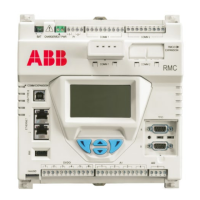2105551MNAD | RMC-100 | 31
the third-party devices performing Ethernet-to-Serial passthrough. The configuration instructions for the
third-party device are provided from their manufacturer. For additional details, refer to the RMC-100 user
manual. See Additional information
for a link to the document.
Using a third-party serial-to-serial Ethernet device does not provide
any integrated monitoring or troub
leshooting capabilities as is provided when using the
XIOs. The configuration of the device requires the vendor’s user interface which is separate
from ABB’s PCCU.
8 Configure input and output
Complete the I/O configurations in PCCU32 Expert view mode and select the I/O System option in the
navigation tree.
8.1 Change view option
The default view is the advanced option. This needs to be changed to expert view to configure the I/O
ports. To change the view option:
1. On the top PCCU32 menu bar, select View.
2. Select the Expert option (Figure 8-1
).
3. Click Yes at the warning and wait for the PCCU32 entry mode screen to refresh.
Figure 8-1: Expert view selection
8.2 Analog input configuration
The analog input configuration sets the AI to support the specific type, measurement and operating
range of the external device. To reflect the external device's AI value range in non-default engineering
units, the AI must be calibrated. For AI calibration, refer to the RMC-100 user manual. Analog inputs can
be configured for voltage or current input signals. Choose the signal type that matches that of the
external device.
To configure the analog input signal mode:
1. Select I/O System on the navigation tree. The Analog Inputs tab displays (Figure 8-2
).
Figure 8-2: Analog input configuration
2. Select the Signal field for the required AI.
3. Select 0-30 Volt or 4-20 mA in the drop-down list.
4. Click Send.
8.3 Analog output configuration
The analog output configuration defines the AO value in percentage of the full scale or in engineering
units. The engineering units depend on the type of external device connected to the AO and its operating
or measurement range.

